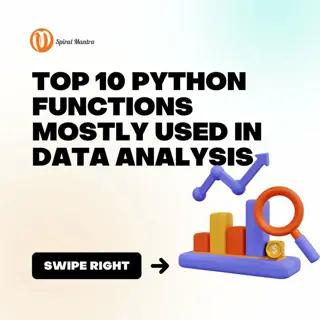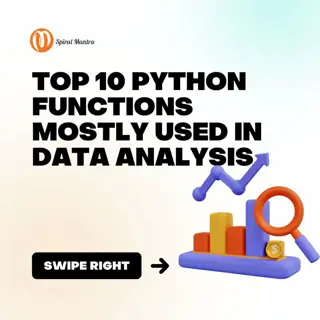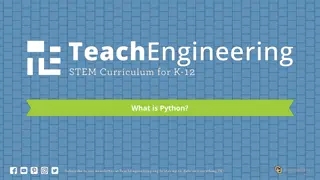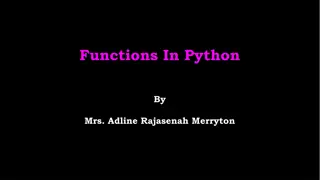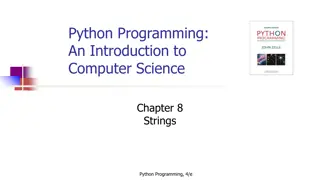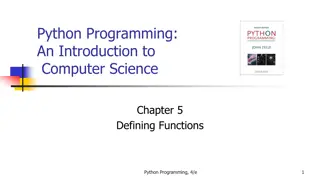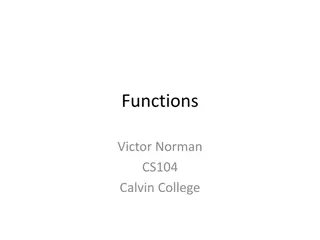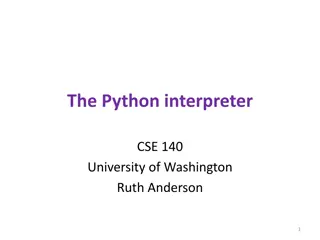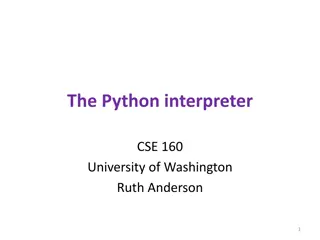Understanding Fruitful Functions in Python
Exploring the concept of fruitful functions in Python, which are functions that return a value defined by the programmer. We delve into the definition, examples, and usage of fruitful functions, along with refactoring techniques and the handling of return values in functions.
Download Presentation

Please find below an Image/Link to download the presentation.
The content on the website is provided AS IS for your information and personal use only. It may not be sold, licensed, or shared on other websites without obtaining consent from the author. Download presentation by click this link. If you encounter any issues during the download, it is possible that the publisher has removed the file from their server.
E N D
Presentation Transcript
Lecture 5 Fruitful Functions Bryan Burlingame 27 February 2019
Announcements Homework 3 due up front Read Chapter 7 & 20
Learning Objectives Revisit functions and discuss return values Incremental development None as a value
Revisiting Functions Recall: Functions are named sequences of instructions which perform some action Functions accept parameters in a parameter list and return values A function call is the activation of a function Python has many built in functions and many additional useful modules Modules are collections of functions with similar purpose Example: the math module with sin, cos, tan, etc. Functions are defined with the def keyword
Fruitful Functions Allen Downey defines a fruitful function as a function which returns a value defined by the programmer The value a function returns is simply called the return value We have been using fruitful functions for some time ex: math.sin(angle) and math.cos(angle) are both fruitful functions
Fruitful Functions Allen Downey defines a fruitful function as a function which returns a value defined by the programmer The value a function returns is simply called the return value We have been using fruitful functions for some time ex: math.sin(angle) and math.cos(angle) are both fruitful functions Recall: one can use a function call anywhere the return value can be used
Defining Fruitful Functions A return value is identified using the return keyword Parameter list Function definition Return value Function call
Refactoring Recall refactoring is the process of restructuring some set of code without changing its function In this example, I ve refactored both the areaRect function and __main__. Which is superior?
Return values Multiple return statements are allowed, though the first return executed ends the function and returns the return value
Return values Multiple return statements are allowed, though the first return executed ends the function and returns the return value What s the return value if the current speed == the speed limit?
Return values Multiple return statements are allowed, though the first return executed ends the function and returns the return value None is the default return value. All void functions actually have a return value: None
Return values All branches in a function should return a value None is the default return value. All void functions actually have
Composition Recall: a function can be called from within another function Problem: find area of a rectangle, given coordinates of opposite corners (12,12) (1,1)
Algorithm Recall: An algorithm is an ordered set of instructions defining some process What is the algorithm necessary to find the area of a rectangle, given the points of the corners?
Algorithm Recall: An algorithm is an ordered set of instructions defining some process What is the algorithm necessary to find the area of a rectangle, given the points of the corners? 1. Obtain the two points 2. Calculate the length of each side 3. Multiply the lengths of the two sides together to obtain the area 4. Return the area
Algorithm Recall: An algorithm is an ordered set of instructions defining some process What is the algorithm necessary to find the area of a rectangle, given the points of the corners? 1. Obtain the two points 2. Calculate the length of each side 3. Multiply the lengths of the two sides together to obtain the area 4. Return the area
Incremental Development Incremental development is the process of developing a program in small chunks (increments) Stub functions are functions which only implement the interfaces (parameter lists and return values) to allow for incremental development Note how areaRect and dist do not do anything, but they do accept the proper values and the do return a value of the proper type
Algorithm The distance between two points uses the distance formula (?1 ?2)2 (?1 ?2)2 ???????? =
Algorithm Area of a rectangle is height * width Note how each function is being tested independently
Incremental Development By building up the program in increments we can test each function separately This allows us to focus on one part at a time Get one thing working before moving on to the next
Recursion Revisited Recursion becomes useful, once each call can return values to the previous call What s the general algorithm to calculate a factorial n == 0? Return 1 otherwise return n * factorial(n- 1)
Recursion Revisited Recursion becomes useful, once each call can return values to the previous call What s the general algorithm to calculate a factorial n == 0? Return 1 otherwise return n * factorial(n- 1) How good is this?
Recursion Revisited Recursion becomes useful, once each call can return values to the previous call What s the general algorithm to calculate a factorial n == 0? Return 1 otherwise return n * factorial(n- 1) How good is this? What is fact(1.5)? What is fact(-1)
Recursion Revisited Better Test for invalid values and then return None when something is invalid, the text calls this a guardian Data validation, bounds check None is not a number, it is the absence of an answer Use the is operator to test for None (== works in the simple cases, is is better) Note that we now have multiple base cases for this function Note the isinstance function, which can be used to check datatype
Resources Downey, A. (2016) Think Python, Second EditionSebastopol, CA: O Reilly Media (n.d.). 3.7.0 Documentation. 6. Expressions Python 3.7.0 documentation. Retrieved September 11, 2018, from http://docs.python.org/3.7/reference/expressions.html


